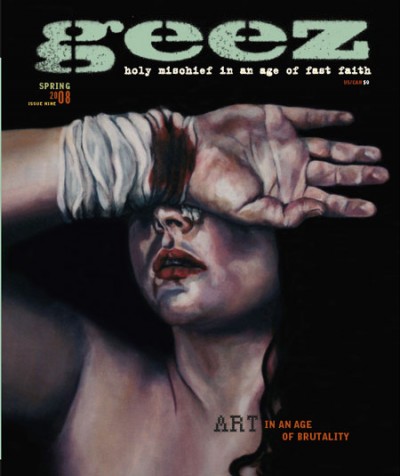Artists point to evil, revitalize hope
When we were asked to be guest art directors for this issue of Geez, we tried to imagine what kinds of art and artists might be aligned with what we saw as the magazine’s mandate, “holy mischief in an age of fast faith.” We began by compiling a list of artists whose work we thought may fit this context, with an emphasis on mischief. We gathered a number of local artists to discuss the magazine and ask if they might like to contribute work. The discussion was lively and suggested a direction for us to pursue.
One of us (Michael) felt the artwork should, in some way, reflect or comment on Judeo-Christian traditions, values or impact on the world. The other focus (which was of greater interest for Diana) was the subversive role of art. Given Geez‘s reputation for confronting social issues, we both wanted to include art or artists whose work doesn’t shy away from challenging ideas.
In being subversive, context is crucial. For example, to be a Goth in a small farming community could be interpreted as subversive. To be openly Christian in a secular art school could be considered equally subversive.
As we considered the content for this issue, we chose artists whose work challenges a particular status quo and questions beliefs many take for granted. A sexually aroused biblical hero, dolls that reinforce cruel stereotypes or images of Christian women in a Nazi salute – these are images that are both pointed and provocative. They stir up emotions and grab you by the lapels, but they do so to raise important issues.
We realize that some of these images are upsetting, but we don’t feel any of them are gratuitous. We feel that these artists and their images confront the passive acceptance of religious doctrine and sanitized versions of history. They compel us to consider what we think we know, and what we have accepted without question.
We have included work that uses the name of God in ways that may be offensive to some. We see them, instead, as offering alternate avenues by which we may approach the Divine. On a similar note, we have selected artists whose work shines a light on the darkness that has been, and continues to be, perpetrated in the name of God. This is one of the important roles artists have – to point out injustice, intolerance and evil wherever they may be found.
Another role of art is to revitalize old traditions. It responds to and re-presents traditional images through contemporary eyes, sometimes turning them upside down, or skewing them for a different or fuller meaning.
At the heart of many of these artworks is an attempt to wipe away the false veneers of convention, to poke and prod at an idea, an image, a tradition, until its complex layers are revealed.
Ultimately, we feel that artmaking is a hopeful act, and that the art we have selected comes from that positive impulse, in spite of the fact that a few of the images presented here may unsettle us. Disturbing imagery reflects disturbing acts, reminding us of the dark side of the human experience. In some cases these images represent deeds we need to rail against, in other cases they highlight situations that should be acknowledged and understood. The hope is that someone is willing to listen, or at least enter into dialogue.
Diana Thorneycroft has exhibited her work both nationally and internationally and is the recipient of numerous grants and awards. She has taught at the University of Manitoba’s School of Art since 1984 and lives in Winnipeg with artist Michael Boss, and their two cats, Doug and Larry.
Michael Boss is Head of Studio Programs at The Winnipeg Art Gallery. He is a practicing artist whose work has been presented in solo and group exhibitions throughout Canada, in the United States and Europe. He is a curious blend of Ukrainian Catholic and Mennonite ancestry.



Sorry, comments are closed.